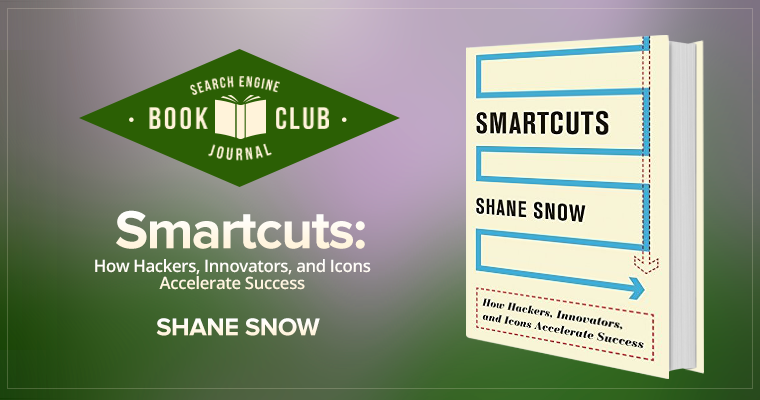Want to see what other books SEJ has covered? Read our other reviews in the SEJ Book Club archive.
As always, I’m excited to have an excuse to read a book that sounds super appealing and useful to my work and life. When I found out about Shane Snow’s Smartcuts: How Hackers, Innovators, and Icons Accelerate Success (affiliate link), I knew it’d be a great addition to the SEJ Book Club shelf.
Here’s some of the biggest takeaways that made an impact on me while reading the book.
Smartcuts is broken into three categories:
- Shorten: The idea that getting to the finish line using untraditional thinking. Just because everyone has always gone the “123” route doesn’t mean you have to. From Snow: “Lateral thinking doesn’t replace hard work; it eliminates unnecessary cycles. Once they’ve shortened their path, over-achievers tend to look for ways to do more with their effort(s).”
- Leverage: Essentially, this boils down to getting the biggest bang for your buck. Utilizing what you have to make a big impact, even if it’s not as much as others.
- Soar: Using the concept of forward movement to continue on the path of making things happen and achieving more than others in your industry.
Shorten

This section breaks up into different chapters, but they all tie into the idea that the traditional path isn’t always what works best for some people.
Snow gives the analogy of the career ladder, which most people climb gradually over many years. Instead, Snow challenges us to think of how we can climb the ladder sideways. This is how many former dancers or singers break into acting and make it big, like Zoe Saldana.
Small wins, even if they are at the same level you already were, can help propel you forward and break through to the next level in your business or career.
Key Takeaway From Shortcuts:
“Traditional paths are not just slow; they’re no longer viable if we want to compete and innovate….To be successful, we need to start thinking more like hackers, acting more like entrepreneurs.”
Leverage
This is probably my favorite section of the book because two of its key concepts: building relationships and placing an emphasis on innovation. Snow’s first example in the second chapter of this section talks about Google’s popular “20% Time” theory, where employees were allotted 20% of their time at work (the equivalent of one eight-hour day in a 40-hour work week) toward projects they’ve come up with on their own. This is how Gmail was created, which is arguably the most popular email service in the world.
Snow says, “This kind of budgeted experimentation helps businesses avoid being disrupted, by helping them harness waves on which other younger competitors might otherwise use to ride past them.”
The other part of this section I enjoyed was about Superconnectors, which is the concept that helping others be their best selves will only help your business in the end. If you build a great product that helps people or you make others look good before thinking of yourself, you reach superconnector status.
Key Takeaway From Shortcuts:
“No matter the medium or method, giving is the timeless smartcut for harnessing superconnectors and creating serendipity.”
Soar

The first two chapters’ titles in this section say it all: Momentum and Simplicity. These words are once we have all heard before, but if you really think about them in terms of your business, they start to make a big difference.
On momentum, Snow states, “Momentum isn’t just a powerful ingredient of success. It’s also a powerful predictor of success.”
And on simplicity, Snow says, “Simplification often makes the difference between good and amazing.”
Once Snow got me thinking about these concepts: the idea that moving things forward in a simpler way on a day-to-day basis, he took us into a great ending concept for Smartcuts: the idea of 10x thinking.
When you want to make something better, don’t think about the next step, think about making something ten times better than it already is. Businesses who have major success, like huge, Elon Musk-level success, are ones who making something 10 times better, not just 10 percent.
Key Takeaway: 10x Thinking
“Big causes attract big believers…and big talent. They force us to rethink convention and hack the ladder of success…To swing and to simplify, to quickly turn failure into feedback. To become not just bigger, but truly better.”
That quote is a great ending to the book and it conceptualizes what the book is all about: how leveraging your passion for making things better by taking untraditional methods can be the difference between major success and repeated failure.
Have you read Smartcuts? What was your favorite concept?
Join Us Next Month!
Next month, Caitlin Rulien, our Social Producer, will read The Power of Habit: Why We Do What We Do in Life and Business (affiliate link), by Charles Duhigg. Pick it up from your local library or from a site like Amazon to read along with her.
Want to see what the SEJ Book Club has read or is planning on reading next? Check out our GoodReads profile and add us as a friend!
This post contains Amazon affiliate links.
Image Credits
Featured Image: Image by Paulo Bobita
In-post Photos, in order: Shutterstock, used under license via users pzAxe and kevinhung.





